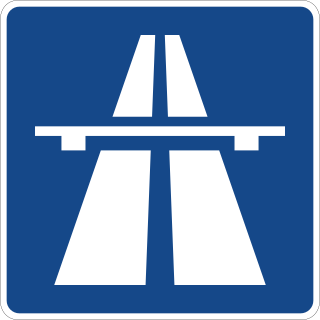
Bundesautobahn 1 is an autobahn in Germany. It runs from Heiligenhafen in Schleswig-Holstein to Saarbrücken, a distance of 749 km (465 mi), but is incomplete between Cologne and Trier. B 207 continues north from Heiligenhafen to Puttgarden, at the end of the island of Fehmarn, with a ferry to Rødby, Denmark.

Bundesautobahn 7 is the longest German Autobahn and the longest national motorway in Europe at 963 km (598 mi). It bisects the country almost evenly between east and west. In the north, it starts at the border with Denmark as an extension of the Danish part of E45. In the south, the autobahn ends at the Austrian border. This final gap was closed in September 2009.

Bundesautobahn 2 is an autobahn in Germany that connects the Ruhr area in the west to Berlin in the east. The A 2 starts at the junction with the A3 near the western city of Oberhausen, passes through the north of the Ruhr valley, through the Münsterland and into Ostwestfalen, crossing the former inner German border and continuing through the Magdeburger Börde to merge into the Berliner Ring shortly before reaching Berlin. Major cities such as Magdeburg, Braunschweig, Hannover and Dortmund are situated very close to the A 2. The A 2 is one of the most important autobahns, connecting several large industrial areas with each other.

Bundesautobahn 5 is a 445 km (277 mi) long Autobahn in Germany. Its northern end is the Hattenbach triangle intersection (with the A 7. The southern end is at the Swiss border near Basel. It runs through the German states of Hessen and Baden-Württemberg and connects on its southern ending to the Swiss A 2.

Bundesautobahn 71 is an Autobahn in Germany. It connects the A 38 and Erfurt to the A 70 near Schweinfurt. A further northern extension to the A 14 near Plötzkau has been proposed by the state government of Sachsen-Anhalt.
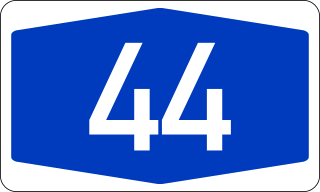
Bundesautobahn 44 is a German Autobahn. It consists of three main parts and a few smaller parts. It begins in Aachen at the German–Belgian border and ends near Kassel. Before the German unification it was an unimportant provincial motorway but after this event it became an integral part of the German highway system. The A 44 is a highly frequented link between the Rhine-Ruhr-Area and the new German states, especially Thuringia, and by proxy, eastern European states like Poland and Ukraine.
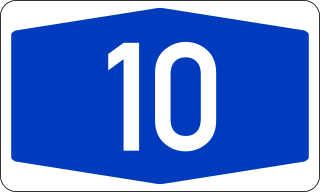
Bundesautobahn 10 is an orbital motorway around the German capital city of Berlin. Colloquially called Berliner Ring, it is predominantly located in the state of Brandenburg, with a short stretch of 5 km in Berlin itself. It should not be confused with the Berliner Stadtring around Berlin's inner city.

Bundesautobahn 9 is an autobahn in Germany, connecting Berlin and Munich via Leipzig and Nuremberg. It's the fifth longest autobahn spanning 529 km (328.71 mi).

Bundesautobahn 20 is an autobahn in Germany. It is colloquially known as Ostseeautobahn or Küstenautobahn due to its geographic location near the Baltic Sea coastline. The road is not built along a straight line, instead it is built near important cities, to make it more beneficial for travel between these cities, and also to serve as bypass.

Bundesautobahn 999 was the designated number for the Mittlerer Ring in Munich, Germany, a projected second ring road around the inner city districts to accompany the Münchner Ring (Bundesautobahn 99). The project to construct the Mittlerer Ring as an autobahn was not carried out, instead the Bundesstraße 2R now covers most of the planned A 999 trajectory.
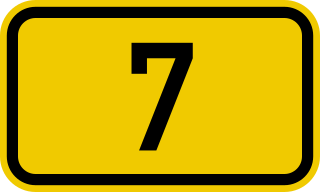
The Bundesstraße 7 is a German federal highway (Bundesstraße) that stretches from the Dutch border at Venlo in the West to Rochlitz near Chemnitz in the East. It is approximately 530 km long. Because of its western origin some stretches of the B 7 are designated as "Holländische Straße", e.g., in Kassel and Calden.

Bundesautobahn 11 is an autobahn in eastern Germany that was opened in 1936. As it is partly in a dilapidated state, it is currently undergoing modernisation works on various stretches. The road forms the main connection between Berlin and Szczecin, and it is connected to the Polish motorway A6 at Mecklenburg-Vorpommern.
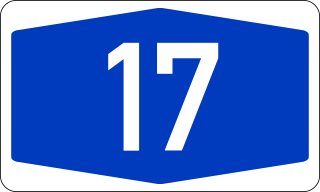
Bundesautobahn 17 is an autobahn in Saxony, south-eastern Germany. It links Dresden to the Czech border where the D8 continues to Prague. Construction began in 1998, and connects to the Prague. The road is a fairly new contribution to the German autobahn-system, with its first stretch opened in 2001 and the last in 2006.
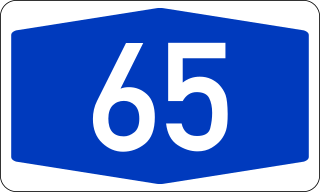
Bundesautobahn 65 is an autobahn in southwestern Germany. The newest section, between Neustadt and Landau, was opened only in the early 1990s.
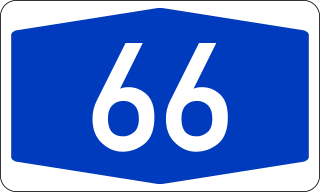
Bundesautobahn 66 is an autobahn in southwestern Germany. It connects the Taunus to Fulda, passing close to Frankfurt am Main. The first part of the autobahn between Wiesbaden and the Nordwestkreuz Frankfurt, was opened as early as 1934, then called the Rhein-Main-Schnellweg. It became an autobahn in 1965.

Bundesautobahn 281 is an autobahn in Bremen in northwestern Germany. The first part was opened in 1995, parts near the Bremen Airport are currently under construction. A second Weser tunnel will be part of the project, presumably being financed as a toll road and built by a private contractor.

Bundesautobahn 241 was an autobahn in Germany. It led around Schwerin and is now part of the A 14.

Bundesautobahn 656 is an autobahn in Germany. It leads from Mannheim-Neckarau to Autobahnkreuz Heidelberg.

Bundesautobahn 100 is an Autobahn in Germany.

Bundesautobahn 535 is an autobahn in Germany.


